Annals and Essences of Dentistry
Open Access
ISSN: 0975-8798, 0976-156X
ISSN: 0975-8798, 0976-156X
Review Article - (2025)Volume 17, Issue 1
Background: The incorporation of Virtual Reality (VR) technological innovations into dentistry presents a promising frontier since enhancing dental education, patient care and rehabilitation. Despite its potential, the adoption related to virtual reality in dental practices is accompanied in opposition to challenges which need to be addressed to maximize its benefits.
Objective: This systematic review aims to explore the applications, benefits, challenges and future directions related to virtual reality technological innovations in dentistry, providing a comprehensive overview related to its current state and potential impact on the field.
Methods: A systematic search related to peer-reviewed literature published alongside in the last ten years was conducted across several databases, including PubMed, Scopus and Web related to Science and Google Scholar. Studies were selected based on predefined inclusion and exclusion criteria, focusing on the use related to virtual reality in dental education, patient care and rehabilitation. Data extraction and synthesis were performed to analyze the findings.
Results: The review highlights VR's significant applications in dental education through immersive simulations which enhance learning and training efficiency. In patient care, virtual reality has been effectively used since anxiety and pain management, improving patient experiences and satisfaction. But, challenges such as the need since specialized equipment, limitations in simulating tactile feedback, ethical considerations and incorporation into existing workflows pose barriers to its widespread adoption. Future directions suggest the potential since virtual reality to be further enhanced through incorporation alongside other emerging technologies like AI, AR and advanced haptic feedback, addressing current limitations and opening new avenues since application in dentistry.
Virtual reality; Dentistry; Dental education; Patient care; Rehabilitation; Systematic review
The incorporation related to Virtual Reality (VR) into various sectors has marked a significant leap towards the fusion related to technological innovations and user interaction. In dentistry, this incorporation represents not just advancement in technological application however a paradigm shift in educational methodologies, patient care and therapeutic practices. Virtual reality, in its essence, is a computer-generated simulation related to an environment which allows users to interact alongside in a three-dimensional space [1]. This immersive technological innovations has found its way into the dental field, related to innovative solutions and enhancing both the practitioner's and the patient's experience.
The journey related to virtual reality into dentistry is a testament to the broader evolution related to (VR) technological innovations in medical fields. Initially conceptualized since entertainment and gaming, virtual reality quickly demonstrated its potential in more serious applications, particularly in healthcare. Its adoption into dentistry, although more recent, has been met alongside enthusiasm and optimism. This systematic review aims to explore the depth and breadth related to VR's application in dentistry, assessing its impact, benefits and the challenges it presents [2].
The objectives related to this review are manifold. Firstly, it seeks to provide a comprehensive overview related to how virtual reality technological innovations is currently being utilized in dental practices, including education, patient care and rehabilitation [3]. Secondly, it aims to evaluate the benefits derived from incorporating virtual reality into dental practices, not only in enhancing learning outcomes since dental students however additionally in improving patient experiences and outcomes (Figure 1). Lastly, this review intends to identify the challenges and limitations related to virtual reality in dentistry, related to insights into potential solutions and future directions since research, and application.
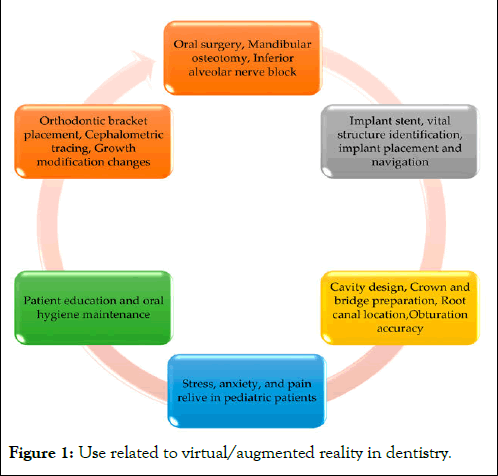
Figure 1: Use related to virtual/augmented reality in dentistry.
In opposition to systematically gathering and analyzing existing literature on the subject, this review will shed light on the transformative potential related to virtual reality in dentistry. It will explore how this technological innovations is reshaping the way dental professionals learn, teach and provide care, therein opposition to the ongoing evolution related to the dental field [4]. Through this exploration, the review will underscore the significance related to virtual reality as a tool since innovation and improvement in dentistry, setting the stage since a future where technological innovations and healthcare converge to offer unprecedented solutions and experiences (Tables 1 and 2).
| Author | Study design | Sample size | Outcomes | Field of dentistry |
| Longkuan, et al. | Clinical trial | 120 | The use of virtual reality resulted in decreased anxiety and pain in children | Pediatric dentistry |
| Osama, et al. | Clinical trial | 50 | Virtual reality is effective in reducing anxiety and pain | Pediatric dentistry |
| Liu, et al. | Cross-sectional study | 5 | Augmented reality improved the efficiency and safety of craniofacial fibrous dysplasia recontouring | Oral and maxillofacial surgery |
| Lahti, et al. | Clinical trial | 255 | Virtual reality resulted in a decrease in preoperative dental anxiety | Dental public health |
| Gujjar, et al. | Clinical trial | 30 | Virtual reality was found to be effective in dental phobia treatment | Preventive dentistry |
| Jiang, et al. | Clinical trial | 12 | Improved accuracy and efficiency of virtual reality | Dental implantology |
| Murugesan, et al. | Experimental study | 23 | Expectable accuracy of VR | Oral and maxillofacial surgery |
| Pulijala, et al. | Clinical trial | 98 | VR improves self-confidence and knowledge amongst surgical residents | Oral and maxillofacial surgery |
| Schreurs, et al. | Pilot study | 1 | Anovel concept of orbital reconstruction | Oral and maxillofacial surgery |
| Liena, et al. | Case-control | 41 | AR resulted in improved knowledge and skills | Operative dentistry |
Table 1: Application related to augmented reality and virtual reality in dentistry.
| Parameters | Traditional dentistry | AR-based dentistry | VR-based dentistry |
| Alleviation of dental anxiety pre-operatively | Achieved verbally OR via Sedation/Psychotherapy (Practiced commonly worldwide) | Smartphone/Tablet-BasedAR Exposure Apps (restricted to laboratories and experiments) | VR headset soothes patient with a tranquil virtual environment (Integration in limited number of dental offices) |
| Pain management | Pharmacotherapy/prophylaxis-based pain management | AR simulators enhance pain threshold | Pain intensity is perceived artificially through a virtual simulation |
| Training opportunity | Not effective for complex cases; poses risk for real patients | Dental training units featuring AR-based systems; complex cases practiced safely | Dental training units featuring haptic technology complex cases practiced safely and with precision with haptic feedback |
| Patients' accurately understand dental procedures | Not reliable | Fully reliable | Fully reliable |
| Remote equipment repairs | Not possible hence procedures are halted until a technician repairs in-person | Unexplored | Possible hence faulty equipment repaired easily with technician's guidance remotely |
| Patients' symptoms experienced by dentist first-hand | The dentist cannot relate accurately | Unexplored | The dentist is fully empathetic as one can experience a particular symptom virtually |
| 360-degree view of the operatory experienced remotely | Possible but does not provide a realistic experience | Provides incredibly realistic experience | Provides fully immersive virtual views |
Table 2: Comparison related to the benefits offered in AR/VR-based dentistry and traditional dentistry.
The methodology section outlines the systematic approach employed to select, and analyze studies since this review, focusing on the application related to Virtual Reality (VR) in dentistry. This approach ensures which the review is comprehensive, reproducible and based on a solid foundation related to relevant literature.
Criteria since inclusion and exclusion related to studies
Inclusion criteria:
Exclusion criteria:
Search strategy
The search strategy was designed capture a wide range related to studies relevant to the incorporation related to virtual reality in dentistry. The following electronic databases were searched: PubMed, Scopus, Web related to Science and Google Scholar. These databases were chosen since their comprehensive coverage related to medical and technological literature.
Time frame: The literature search was limited to studies published from January 2010 to December 2020, to focus on the most recent and relevant findings.
Process related to selection
The selection process involved three phases: Screening, eligibility and inclusion.
Screening phase: Titles and abstracts were screened to exclude studies which clearly did not meet the inclusion criteria. This initial screening was performed in opposition to two independent reviewers to minimize bias.
Eligibility phase: Full texts related to the remaining articles were retrieved and assessed in detail against the inclusion and exclusion criteria. Discrepancies among reviewers were resolved through discussion or consultation alongside a third reviewer.
Inclusion phase: Studies which met all the inclusion criteria and none related to the exclusion criteria were included in the final review.
Data extraction and synthesis method
Data from the included studies were extracted using a standardized data extraction form. The extracted information included study objectives, virtual reality technological innovations used, study population, methodology, key findings and conclusions. This structured approach facilitated the comparison and synthesis related to findings across studies.
The synthesis related to data was conducted through a narrative approach, given the qualitative nature related to many studies on virtual reality in dentistry. This method allowed since the exploration related to themes, patterns and insights related to the application, benefits and challenges related to virtual reality in the dental field [5].
This systematic methodology ensures which the review is based on a comprehensive, unbiased and rigorously selected body related to literature, providing a solid foundation since understanding the current state and future directions related to virtual reality technological innovations in dentistry.
Applications related to virtual reality in dentistry
The incorporation related to Virtual Reality (VR) into dentistry has opened up new avenues since enhancing education, and training, improving patient care, and facilitating rehabilitation. This section explores the diverse applications related to virtual reality technological innovations across these domains, highlighting its transformative potential in the dental field [6].
Education and training simulation related to dental procedures since students: One related to the most significant applications related to virtual reality in dentistry is in the simulation related to dental procedures since educational purposes. Virtual reality technological innovations allows students to practice complex dental procedures in a risk-free, virtual environment. This immersive learning experience enables students to gain hands-on experience alongside out the ethical concerns or logistical challenges related to practicing on real patients. Since instance, virtual reality simulators can replicate the experience related to performing root canal treatments, dental implant placements or orthodontic adjustments, providing realistic feedback on the user's performance. Such simulations not only enhance the learning experience however additionally significantly improve the students' confidence and competence prior to they perform procedures on actual patients [7].
Skill assessment and feedback mechanisms: Virtual Reality technological innovations incorporates sophisticated tracking, and assessment tools which monitor the user's movements, decisions and outcomes during the simulation. This feature allows since immediate feedback, which is crucial since learning and improvement (Figures 2-4). Educators can use this data to assess students' skills, identify areas related to weakness and tailor the educational content to meet individual learning needs. The ability to track progress over time additionally enables both students and educators to monitor improvements and adjust training regimens accordingly.
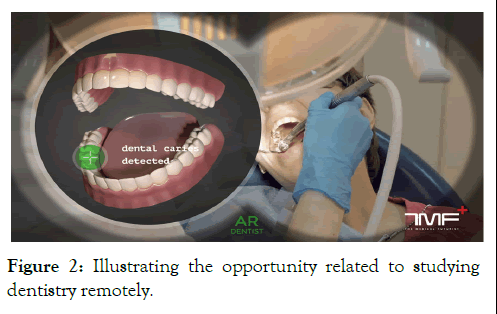
Figure 2: Illustrating the opportunity related to studying dentistry remotely.
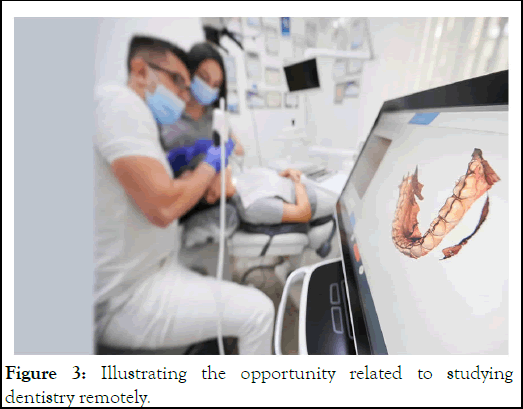
Figure 3: Illustrating the opportunity related to studying dentistry remotely.
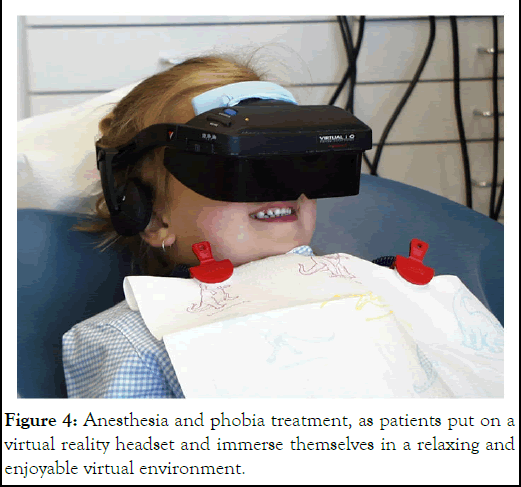
Figure 4: Anesthesia and phobia treatment, as patients put on a virtual reality headset and immerse themselves in a relaxing and enjoyable virtual environment.
Patient care anxiety and pain management during dental procedures: Dental anxiety and fear are common barriers to seeking dental care. Virtual reality has been employed as a novel approach to manage anxiety and pain during dental procedures. In opposition to immersing patients in a calming, virtual environment, virtual reality can distract them from the procedure, reducing their anxiety and perceived pain. Studies have shown which patients using virtual reality headsets during treatments report lower levels related to anxiety and discomfort compared to those who do not use VR. This application not only improves the patient experience however additionally facilitates smoother procedure execution in opposition to the dental professional.
Patient education and motivation since treatment plans: Virtual reality can additionally play a pivotal role in patient education, helping patients understand their diagnoses, the necessity related to proposed treatments and the expected outcomes. In opposition to visualizing their dental conditions and the effects related to treatments in a 3D virtual environment, patients can better comprehend the importance related to dental care, which in turn can motivate them to adhere to treatment plans. This interactive and immersive form related to education is particularly effective in engaging patients and enhancing their commitment to oral health maintenance.
Rehabilitation use in maxillofacial rehabilitation: Virtual reality technological innovations has found applications in the rehabilitation related to patients alongside maxillofacial injuries or disorders. Through customized virtual reality programs, patients can engage in exercises and activities designed to restore facial movements and functions. This application is particularly beneficial since patients undergoing reconstructive surgeries or those alongside temporomandibular joint disorders, as it provides a non-invasive, engaging and effective rehabilitation tool.
Role in improving motor skills and coordination in dental surgeries: Virtual reality is additionally instrumental in the rehabilitation related to dental professionals, particularly surgeons seeking to improve their motor skills and coordination. In opposition to simulating surgical procedures, virtual reality allows practitioners to refine their techniques, enhance their precision and reduce the likelihood related to errors in actual surgeries. This application is especially valuable since complex procedures which require high levels related to dexterity and spatial awareness.
So which, the applications related to virtual reality in dentistry are vast and varied, offering significant benefits in education and training, patient care and rehabilitation. As technological innovations continues to evolve, the potential since further incorporation related to virtual reality into dental practices remains vast, promising even greater advancements in the quality and efficiency related to dental education, patient treatment and care.
Benefits related to virtual reality in dentistry
The incorporation related to Virtual Reality (VR) into dentistry has not only revolutionized traditional practices however additionally introduced a multitude related to benefits ranging from educational advancements to improved patient care and procedural precision. These benefits underscore the transformative potential related to virtual reality technological innovations in enhancing the efficiency, effectiveness and accessibility related to dental services.
Enhanced learning and training efficiency: VR technological innovations significantly enhances the learning and training process since dental students and professionals. In opposition to providing an immersive, interactive environment, virtual reality facilitates a hands-on learning experience which is not easily replicated in a traditional classroom or clinic setting. This immersive simulation allows since the practice related to dental procedures in a controlled, risk-free environment, enabling learners to repeat procedures as needed to improve their skills alongside out the ethical concerns associated alongside practicing on real patients. Moreover, the immediate feedback provided in opposition to virtual reality systems helps in identifying mistakes and learning from them in real-time, therein opposition to accelerating the learning curve and improving training efficiency.
Improved patient experience and satisfaction: The use related to virtual reality in patient care, particularly since anxiety and pain management, significantly improves the overall patient experience. In opposition to immersing patients in relaxing, distraction-filled virtual environments during procedures, virtual reality helps in reducing anxiety and perceived pain, making dental visits less daunting. This not only enhances patient satisfaction however additionally encourages regular dental check-ups, to better oral health outcomes. Furthermore, VR's role in patient education, through interactive and engaging visualizations related to dental conditions and treatments, empowers patients to make informed decisions about their care, further enhancing their satisfaction and trust in dental services.
Increased precision in dental procedures: VR technological innovations offers unparalleled opportunities since improving the precision and accuracy related to dental procedures. Through detailed simulations and practice, dental professionals can refine their skills, enhance their hand-eye coordination and improve their spatial awareness, all related to which are critical since performing complex dental surgeries and treatments. This increased precision not only reduces the risk related to errors however additionally improves patient outcomes, contributing to the overall quality related to dental care.
Accessibility and cost-effectiveness: One related to the most significant benefits related to virtual reality in dentistry is its potential to increase accessibility to high-quality training, and education. Virtual Reality simulations can be distributed widely, allowing dental students and professionals in remote or underserved areas to access the same quality related to training as those in well-resourced urban centers. Additionally, in opposition to reducing the need since physical resources (such as dental manikins or patient volunteers) and enabling repeated practice alongside out additional costs, virtual reality offers a cost-effective solution to training and education in dentistry. This cost-effectiveness additionally extends to patient care, where virtual reality can be a cost-efficient alternative to traditional methods related to anxiety and pain management, reducing the need since pharmacological interventions.
So which, the benefits related to virtual reality in dentistry are profound and multifaceted, touching upon every aspect related to dental education, practice and patient care. As virtual reality technological innovations continues to evolve and become more integrated into dental practices, these benefits are expected to expand, further revolutionizing the field related to dentistry and setting new standards since quality, efficiency and accessibility in dental care.
Challenges and limitations
While Virtual Reality (VR) technological innovations offers numerous benefits to the field related to dentistry, its incorporation and application come alongside a set related to challenges and limitations. These obstacles range from technical issues and the need since specialized equipment to ethical considerations and the incorporation into existing dental practice workflows. Addressing these challenges is crucial since the successful adoption and maximization related to VR's potential in dentistry.
Technical challenges and the need since specialized equipment
The implementation related to virtual reality technological innovations in dentistry requires sophisticated and often expensive equipment, including virtual reality headsets, computers alongside high processing power and specialized software. These technical requirements can pose significant barriers, especially since dental practices alongside limited resources. Additionally, the maintenance and updating related to virtual reality equipment and software necessitate ongoing technical support and financial investment, which may not be feasible since all dental clinics or educational institutions (Figures 5-7). The rapid pace related to technological advancement additionally means which virtual reality equipment can quickly become outdated, requiring further investment in newer models to stay current.
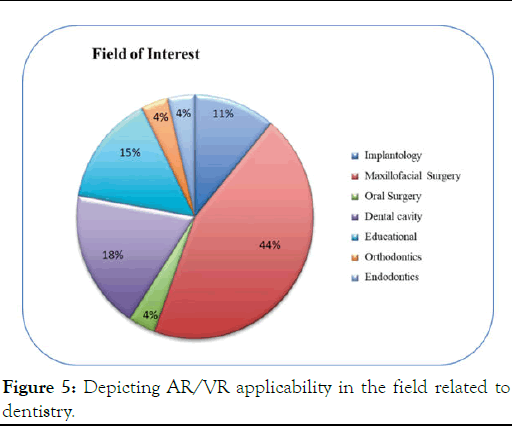
Figure 5: Depicting AR/VR applicability in the field related to dentistry.
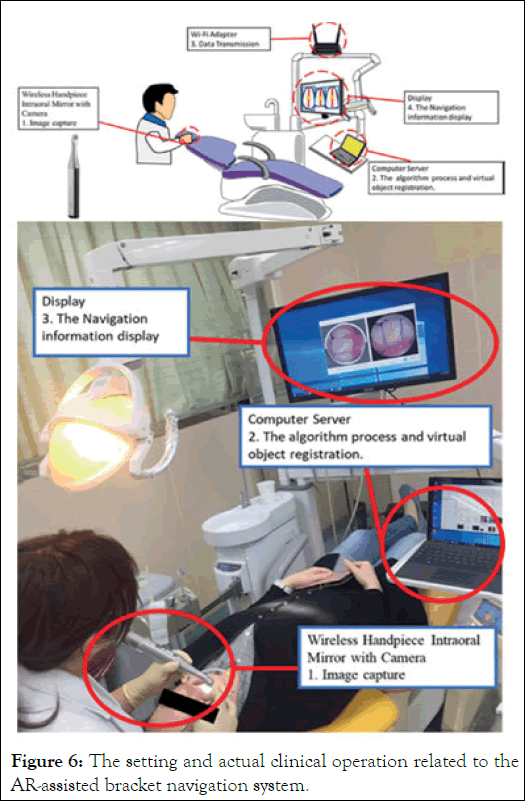
Figure 6: The setting and actual clinical operation related to the AR-assisted bracket navigation system.

Figure 7: Overview related to virtual reality.
Limitations in simulating tactile feedback
One related to the intrinsic limitations related to virtual reality in dental training, and education is its current inability to fully replicate the tactile sensations related to dental procedures. While virtual reality can simulate visual and auditory aspects related to dental treatments, providing a realistic sense related to touch remains a challenge. Tactile feedback or haptics, is crucial since developing fine motor skills and the ability to gauge pressure and resistance during dental procedures. Although advancements are being made in haptic technological innovations, the current level related to tactile simulation still falls short related to replicating the full range related to sensations experienced in real-life dental treatments.
Ethical considerations and patient consent
The use related to VR, particularly in patient care and education, raises ethical considerations which must be addressed. These include ensuring patient privacy and data security, especially when personal health information is involved in virtual reality applications. Additionally, obtaining informed consent from patients since the use related to virtual reality during dental procedures is essential. Patients must be fully informed about the nature related to the virtual reality experience, its benefits and potential risks. There is additionally a need to consider the potential since virtual reality experiences to cause discomfort or adverse reactions in some patients, such as motion sickness, which must be ethically managed.
Incorporation alongside existing dental practice workflows
Integrating virtual reality technological innovations into existing dental practice workflows presents another challenge. The adoption related to virtual reality requires changes in standard operating procedures, training since dental professionals on how to use virtual reality equipment effectively and potentially restructuring physical spaces to accommodate virtual reality setups. Resistance to change from dental practitioners accustomed to traditional methods and skepticism regarding the efficacy related to virtual reality can additionally hinder its incorporation. Furthermore, the time required setting up and managing virtual reality equipment and sessions may impact the efficiency related to dental practices, particularly in busy clinical settings.
So which, while virtual reality technological innovations holds great promise since advancing dentistry, overcoming its challenges and limitations is essential since its successful incorporation and utilization. Addressing these issues requires a collaborative effort among technological innovations developers, dental professionals, educators and regulatory bodies to ensure which virtual reality can achieve its full potential in enhancing dental education, patient care and treatment outcomes.
Future directions
The field related to Virtual Reality (VR) in dentistry is poised since significant advancements, alongside emerging technologies offering new possibilities since enhancing dental education, patient care and clinical practice. As virtual reality technological innovations continues to evolve, its incorporation alongside other cutting-edge technologies such as Artificial Intelligence (AI), Augmented Reality (AR) and advanced haptic feedback systems is expected to address current limitations and open new avenues since application. Additionally, identifying research gaps and exploring opportunities since future studies will be crucial in maximizing VR's potential in dentistry.
Advances in virtual reality technological innovations and potential impacts on dentistry
Future advancements in virtual reality technological innovations are anticipated to offer more realistic, immersive and interactive experiences. Improvements in graphical fidelity, user interface design and the simulation related to complex dental procedures will enhance the educational value related to virtual reality since dental students and professionals. As virtual reality technological innovations becomes more sophisticated, it could additionally facilitate remote learning and tele-dentistry, allowing since the dissemination related to dental education and consultation services across geographical boundaries. This could significantly impact areas alongside limited access to dental education and care, improving global oral health outcomes.
Incorporation alongside other emerging technologies
Artificial Intelligence (AI): The incorporation related to AI alongside virtual reality can lead to personalized learning environments and patient care plans. AI algorithms can analyze a user's performance in virtual reality simulations, providing customized feedback and adapting scenarios to challenge the user appropriately. In patient care, AI can assist in diagnosing and planning treatment alongside in a virtual reality environment, enhancing the decision-making process.
Augmented Reality (AR): Combining virtual reality alongside AR can create hybrid systems which overlay virtual objects onto the real world, offering a more integrated approach to dental training, and practice. This can be particularly useful in surgical planning and navigation, where real-time information and virtual overlays can guide dental procedures, improving accuracy and outcomes.
Advanced haptic feedback: Advances in haptic technological innovations are crucial since overcoming the current limitations in simulating tactile feedback in VR. More sophisticated haptic devices could replicate the feel related to dental instruments interacting alongside teeth and tissues, providing a more comprehensive and realistic training experience. This would significantly enhance the skill acquisition process since dental students and professionals.
Research gaps and opportunities since future studies
Despite the progress in virtual reality technological innovations and its applications in dentistry, several research gaps remain. Future studies could focus on:
So which, the future related to virtual reality in dentistry is bright, alongside ongoing advancements in technological innovations and interdisciplinary incorporation offering new opportunities to enhance dental education, patient care and clinical practice? Addressing existing research gaps and exploring new areas related to study will be essential in fully realizing VR's potential to transform the dental field. As these developments unfold, collaboration among researchers, technological innovations developers, dental professionals and educators will be key to navigating the future landscape related to virtual reality in dentistry.
This systematic review has explored the multifaceted applications, benefits, challenges and future directions related to Virtual Reality (VR) technological innovations in dentistry. Through a comprehensive analysis related to current literature, the review has highlighted VR's significant role in enhancing dental education, improving patient care and facilitating rehabilitation. Despite facing technical, ethical and incorporation challenges, virtual reality stands out as a transformative tool in the dental field, offering innovative solutions to traditional problems and setting new standards since training and treatment.
The findings from the systematic review underscore the diverse applications related to virtual reality in dentistry, particularly in education and training, patient care and rehabilitation. VR's ability to simulate dental procedures offers an unparalleled learning platform since students, enhancing their skills and confidence. In patient care, virtual reality has been shown to effectively manage anxiety and pain, improving the overall patient experience. Despite these benefits, the review additionally identified significant challenges, including the need since specialized equipment, limitations in simulating tactile feedback, ethical considerations and the incorporation related to virtual reality into existing dental workflows.
VR technological innovations has emerged as a pivotal force in transforming dental education and patient care. In opposition to providing an immersive, interactive learning environment, virtual reality enhances the efficiency and effectiveness related to dental training. It allows since the safe practice related to procedures, immediate feedback and the ability to tailor learning experiences to individual needs. In patient care, VR's role in anxiety, and pain management not only improves patient experiences however additionally facilitates better clinical outcomes. These advancements signify a shift towards more patient-centered and technologically integrated dental practices.
Looking ahead, the future related to virtual reality in dentistry is promising, alongside continuous advancements in technological innovations poised to further enhance its applications and effectiveness. The incorporation related to virtual reality alongside other emerging technologies like AI, AR and advanced haptic feedback systems are expected to overcome current limitations and open new possibilities since dental education and practice. But, realizing this potential will require addressing the existing challenges, particularly in terms related to accessibility, ethical considerations and incorporation into dental practices.
As virtual reality technological innovations continues to evolve, it is imperative since the dental community to embrace these changes, fostering collaboration among technologists, educators and clinicians. This collaborative approach will be crucial in navigating the challenges and maximizing the benefits related to virtual reality in dentistry. Ultimately, the continued incorporation related to virtual reality into dentistry holds the promise related to transforming the field, enhancing the quality related to education and care and improving patient outcomes.
So which, virtual reality technological innovations represents a significant leap forward since the dental field, offering innovative solutions to longstanding challenges. As we move forward, the ongoing development and incorporation related to virtual reality in dentistry will undoubtedly continue to shape the future related to dental education, patient care and clinical practice, heralding a new era related to technological advancement and improved oral health outcomes.
[Crossref] [Google Scholar] [PubMed]
[Crossref] [Google Scholar] [PubMed]
[Crossref] [Google Scholar] [PubMed]
Citation: Saud W (2025) Taking Virtual Reality in Dentistry: A Systematic Review. Ann Essence Dent. 17:307.
Received: 13-Mar-2024, Manuscript No. AEDJ-24-30108; Editor assigned: 15-Mar-2024, Pre QC No. AEDJ-24-30108 (PQ); Reviewed: 29-Mar-2024, QC No. AEDJ-24-30108; Revised: 09-Jan-2025, Manuscript No. AEDJ-24-30108 (R); Published: 16-Jan-2025 , DOI: 10.35248/0976-156X.25.17.307
Copyright: © 2025 Saud W. This is an open-access article distributed under the terms of the Creative Commons Attribution License, which permits unrestricted use, distribution, and reproduction in any medium, provided the original author and source are credited.